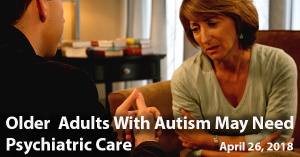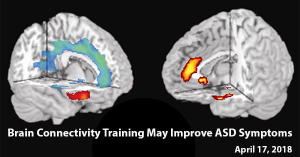Archives
April, 2018
Select a different month in the archive
Older Adults with Autism May Need Psychiatric Care
By Chelsea Toledo, M.A. on April 26, 2018

Background: While Autism Spectrum Disorder (ASD) is most often diagnosed in childhood, the disorder affects people of all ages. However, very little research has been to assess the needs of older adults with ASD.
What’s New: A recent study looked into co-occurring conditions in people over the age of 50 with ASD. The researchers examined data from more than 600 individuals who were eligible for disability services in Sweden between 2002 and 2012 – all with ASD diagnoses. They aimed to determine the rates of intellectual disability, affective disorders, mental illness, substance abuse, and pharmaceutical prescriptions in this group.
The researchers found:
- The majority of individuals in this group (57%) had no intellectual disability.
- Half of the individuals assessed had at least one psychiatric disorder, and the most commonly diagnosed were affective disorders such as bipolar.
- Most of the group (63%) had received some sort of psychiatric care.
- Individuals in this group were very likely to have been prescribed some sort of psychotropic medication – with 63% of patients with no diagnosed intellectual disability and 84% of patients with intellectual disability having been prescribed antipsychotic drugs.
Why it’s important: This study suggests that older people living with ASD have a need for psychiatric care services. Further study of this group could find explanations for the patterns in co-occuring conditions (such as higher rates of psychiatric disorders among people with Asperger’s syndrome), and guide therapeutic interventions for this vulnerable group.
Help me understand :
| Source(s) : |
| Tweet |
Neurofeedback Training Improves Brain Connectivity in People with ASD
By Chelsea Toledo, M.A. on April 17, 2018

Background: In recent years, researchers and clinicians have begun to leverage on brain imaging technology to provide “neurofeedback.” Through this process, they image the brain for aberrant activity and provide positive feedback when desired activity in that area is achieved. That positive feedback can take the form of a green light or another positive signal to participants.
What’s New: A recent study assessed the effectiveness of neurofeedback using functional magnetic resonance imaging, or fMRI, in young adult and adolescent males with ASD. The researchers conducted four training sessions over a period of eight days in 17 males with ASD, between the ages of 15 and 25, alongside 11 age-matched controls with typical development. Each training consisted of a series of “rest scans” with no task for the participant, along with a series of “puzzle tasks,” during which the participants attempted to reveal a hidden picture underneath a blank screen. When the participants exhibited the desired brain activity, positive feedback was given via revealing part of the picture and playing an upbeat sound.
The researchers found:
- The training resulted in improved connectivity in the whole brain, with the greatest differences observed in connectivity between two regions of interest, which previous research has linked to ASD. These changes were not found in the control group.
- The observed improvements in connectivity continued in subsequent “rest scans.”
- The improvements in brain connectivity correlated with improvements in the ASD participants’ behavior, as assessed by behavioral questionnaires filled out by parents before and after the series of trainings.
Why it’s important: This study provides further evidence of the role of brain connectivity in ASD. It also points to a potentially effective and non-invasive treatment option to address related behavioral issues. Larger studies including other participants (e.g., children and female groups) could further explore this possibility.
Help me understand :
| Source(s) : |
| Tweet |

